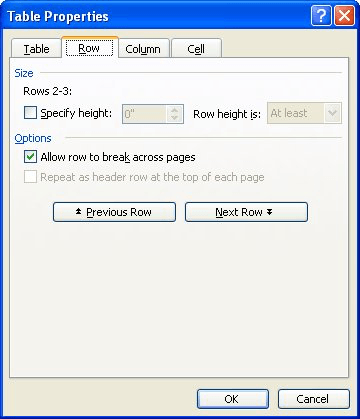Please Note: This article is written for users of the following Microsoft Word versions: 97, 2000, 2002, and 2003. If you are using a later version (Word 2007 or later), this tip may not work for you. For a version of this tip written specifically for later versions of Word, click here: Limiting Lines in a Table Cell.
Written by Allen Wyatt (last updated September 16, 2023)
This tip applies to Word 97, 2000, 2002, and 2003
Maria has a table that she doesn't want to extend past three lines vertically in any given cell. She wonders if there is a way to lock how many lines there can be in any given cell of a table.
Normally the height of a row (which, of course, controls the height of cells in that row) can vary from row to row. Word does this so that whatever you place in the row can be fully accommodated by the table. There may be times when you don't want the row to expand, but instead you want the row to be a specific height.
Here's how you can set the row height to only allow three lines of text:

Figure 1. The Row tab of the Table Properties dialog box.
Now your row height will never go above whatever you set in step 4.
WordTips is your source for cost-effective Microsoft Word training. (Microsoft Word is the most popular word processing software in the world.) This tip (8133) applies to Microsoft Word 97, 2000, 2002, and 2003. You can find a version of this tip for the ribbon interface of Word (Word 2007 and later) here: Limiting Lines in a Table Cell.

Learning Made Easy! Quickly teach yourself how to format, publish, and share your content using Word 2021 or Microsoft 365. With Step by Step, you set the pace, building and practicing the skills you need, just when you need them! Check out Microsoft Word Step by Step today!
When creating a table, you can turn the orientation of the text, within a cell, by ninety degrees in either direction ...
Discover MoreWhen you insert a table into your document, it uses a standard-weight line around each cell in the table. If you want to ...
Discover MoreIf you need to format a number so that it appears as currency, it is not as easy to do in Word as it is in Excel. You can ...
Discover MoreFREE SERVICE: Get tips like this every week in WordTips, a free productivity newsletter. Enter your address and click "Subscribe."
There are currently no comments for this tip. (Be the first to leave your comment—just use the simple form above!)
Got a version of Word that uses the menu interface (Word 97, Word 2000, Word 2002, or Word 2003)? This site is for you! If you use a later version of Word, visit our WordTips site focusing on the ribbon interface.
Visit the WordTips channel on YouTube
FREE SERVICE: Get tips like this every week in WordTips, a free productivity newsletter. Enter your address and click "Subscribe."
Copyright © 2025 Sharon Parq Associates, Inc.
Comments